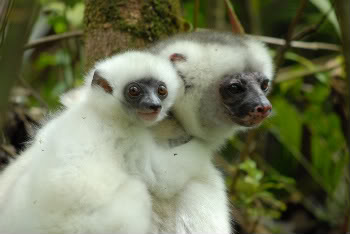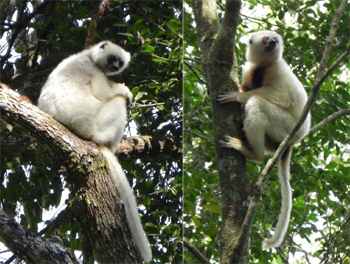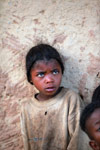A survey of a remote forest area in Madagascar turned up seven new groups of silky sifaka, a critically endangered lemur threatened by habitat destruction. The finding raises hope that the species—which is listed as one of the world’s 25 most endangered primates—is surviving in Marojejy National Park despite an outbreak of illegal rosewood logging in 2009 and 2010.
The seven week expedition was led by Cornell University’s Erik Patel, who heads SIMPONA, a non-profit organization that aims to protect the silky sifaka and its habitat. Patel’s team has found 31 silky sifaka groups consisting of 131 total individuals in Marojejy National Park in the past few years. SIMPONA was joined in the most recent survey by Madagascar National Parks, Madagascar’s protected areas authority.
“I am encouraged by our latest survey results,” Patel told mongabay.com. “Our latest survey region had been heavily impacted by illegal rosewood extraction in 2004/5 and 2009/2010. It was a relief that we did not find any active rosewood logging.”
“We are all just grateful that Marojejy National Park remains so much calmer than Masoala National Park, for example, where illegal rosewood logging continues at a high level.”
 Adult female silky sifaka with six-week-old. Photo by Jeff Gibbs. |
The survey, which assessed 24 square kilometers of rugged terrain, counted 23 individuals among the seven groups. Patel said the number is relatively low given the area assessed, but noted that the silky sifaka has “patchy” population distribution, making it difficult to extrapolate the total population for the species. He says more surveys are needed to “firm numbers” on the total number of silky sifakas remaining, but cautions that despite the new discovery, the species is very much imperiled.
“Silky sifakas are one of the rarest animals on earth and it is shocking to consider how few remain,” he said, noting the species does not survive in captivity.
Lemur Survey in North-Eastern Marojejy National Park (Andalangy) [PDF – 2.3MB]
Q&A with Erik Patel
About how many Silky Sifakas do you estimate remain in the wild?
Patel: Silky sifakas are one of the rarest animals on earth and it is shocking to consider how few remain.
Over the past few years, our team has found 31 groups (131 total individuals) of silky sifakas in Marojejy National Park which contains the majority of their remaining population.
Certainly, there are less then a few thousand silky sifakas remaining in the wild, and none at all are found in captivity because they have never survived in zoos anywhere.
 Silky Sifaka in Andalangy (left), Silky sifaka adult male with chest patch in Andalangy (right). Photographer: Des Kely |
Until we complete more surveys over the next few years, I am reluctant to put firm numbers on the total number of silky sifakas remaining. Aside from the very challenging mountainous terrain, the main difficulty is that their population distribution is patchy (not continuous) within their potential habitat. This is particularly true in the vast Makira Natural Park, which is the largest continuous rainforest in Madagascar, where only a few silky sifaka groups have been found in a few very widely separated regions despite numerous surveys. We can’t simply extrapolate from local density estimates or home range size (which we know for some groups). Doing so, might overestimate how many remain, and that must be avoided.
Are you encouraged by these results?
Patel: I am encouraged by our latest survey results which was a joint collaboration with Madagascar National Parks. Our latest survey region had been heavily impacted by illegal rosewood extraction in 2004/5 and 2009/2010. It was a relief that we did not find any active rosewood logging and that we found 7 new groups of silky sifakas. Keep in mind, however, that our team spent seven weeks in the heart of Marojejy and surveyed about 24 square kilometers. Seven new groups of silkies is actually rather few given how much ground was covered. We are all just grateful that Marojejy National Park remains so much calmer than Masoala National Park, for example, where illegal rosewood logging continues at a high level.
Did you find anything else encouraging during the survey?
Patel: I was relieved that on this survey no local legends of “Giant Man Eating Snakes” were reported because our survey team was a little freaked out on a previous survey when so many villagers were scaring them with these legends!
How were the field conditions?
Patel: All of our surveys are in mountainous, muddy, terrain in remote areas often with no road access. Usually it takes days of walking to get to these places and camping along the way. Many of the regions we are going to have never been investigated by researchers before or at least not in a very long time. Outrageous numbers of porters and rice are needed. During this survey we used 420 kg of rice (926 pounds) and hired more than 40 porters to help the team carry it all.
Related articles
Coup leaders sell out Madagascar’s forests, people

(01/27/2010) Madagascar is renowned for its biological richness. Located off the eastern coast of southern Africa and slightly larger than California, the island has an eclectic collection of plants and animals, more than 80 percent of which are found nowhere else in the world. But Madagascar’s biological bounty has been under siege for nearly a year in the aftermath of a political crisis which saw its president chased into exile at gunpoint; a collapse in its civil service, including its park management system; and evaporation of donor funds which provide half the government’s annual budget. In the absence of governance, organized gangs ransacked the island’s biological treasures, including precious hardwoods and endangered lemurs from protected rainforests, and frightened away tourists, who provide a critical economic incentive for conservation. Now, as the coup leaders take an increasingly active role in the plunder as a means to finance an upcoming election they hope will legitimize their power grab, the question becomes whether Madagascar’s once highly regarded conservation system can be restored and maintained.
Lessons from the crisis in Madagascar, an interview with Erik Patel

(08/11/2009) On March 17th of this year the President of Madagascar, Marc Ravalomanana, resigned his post. This made way for Andry Rajoelina, mayor of Madagascar’s capital, to install himself as president with help from the military. The unrest and confusion that usually accompanies such a coup brought disaster on many of Madagascar’s biological treasures. Within days of Ravalomanana’s resignation, armed gangs, allegedly funded by Chinese traders, entered two of Madagascar’s world-renowned national parks, Marojejy and Masoala parks, and began to log rosewood, ebonies, and other valuable hardwoods. The pillaging lasted months but the situation began to calm down over the summer. Now that the crisis in Madagascar has abated—at least for the time being—it’s time to take stock. In order to do so, Mongabay spoke to Erik Patel, an expert on the Critically Endangered Silky Sifaka and frequent visitor to Madagascar, to find out what the damage looks like firsthand and to see what lessons might be learned.